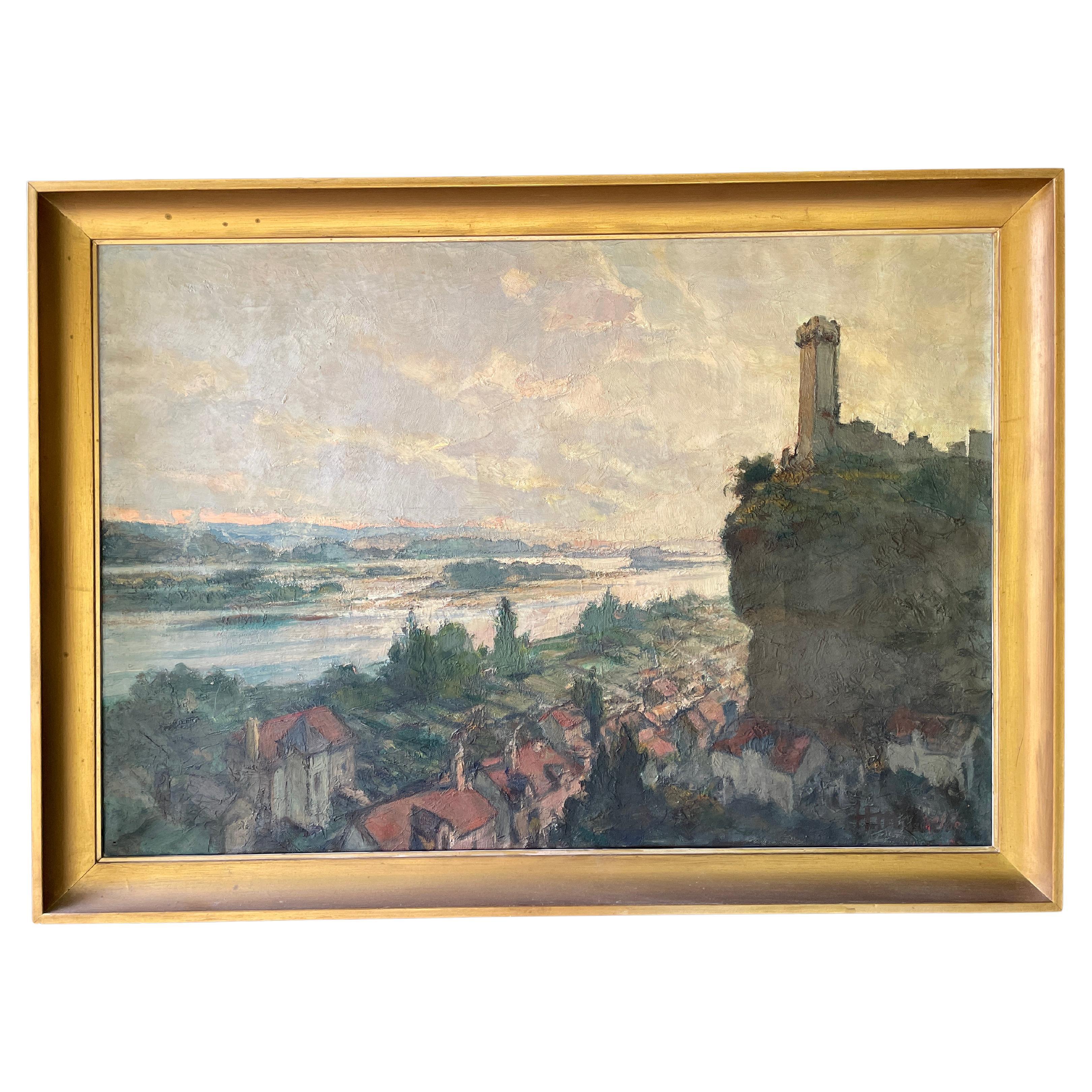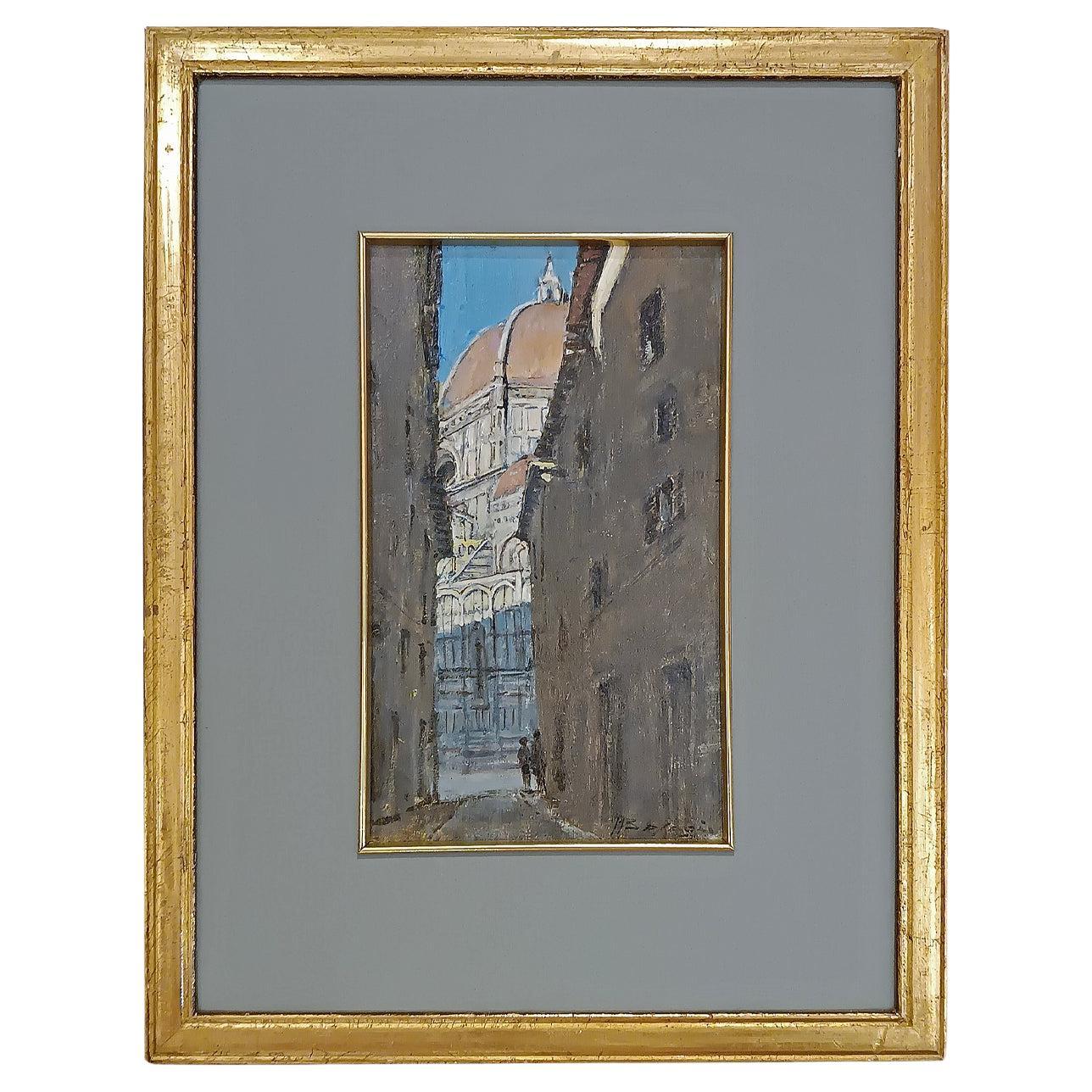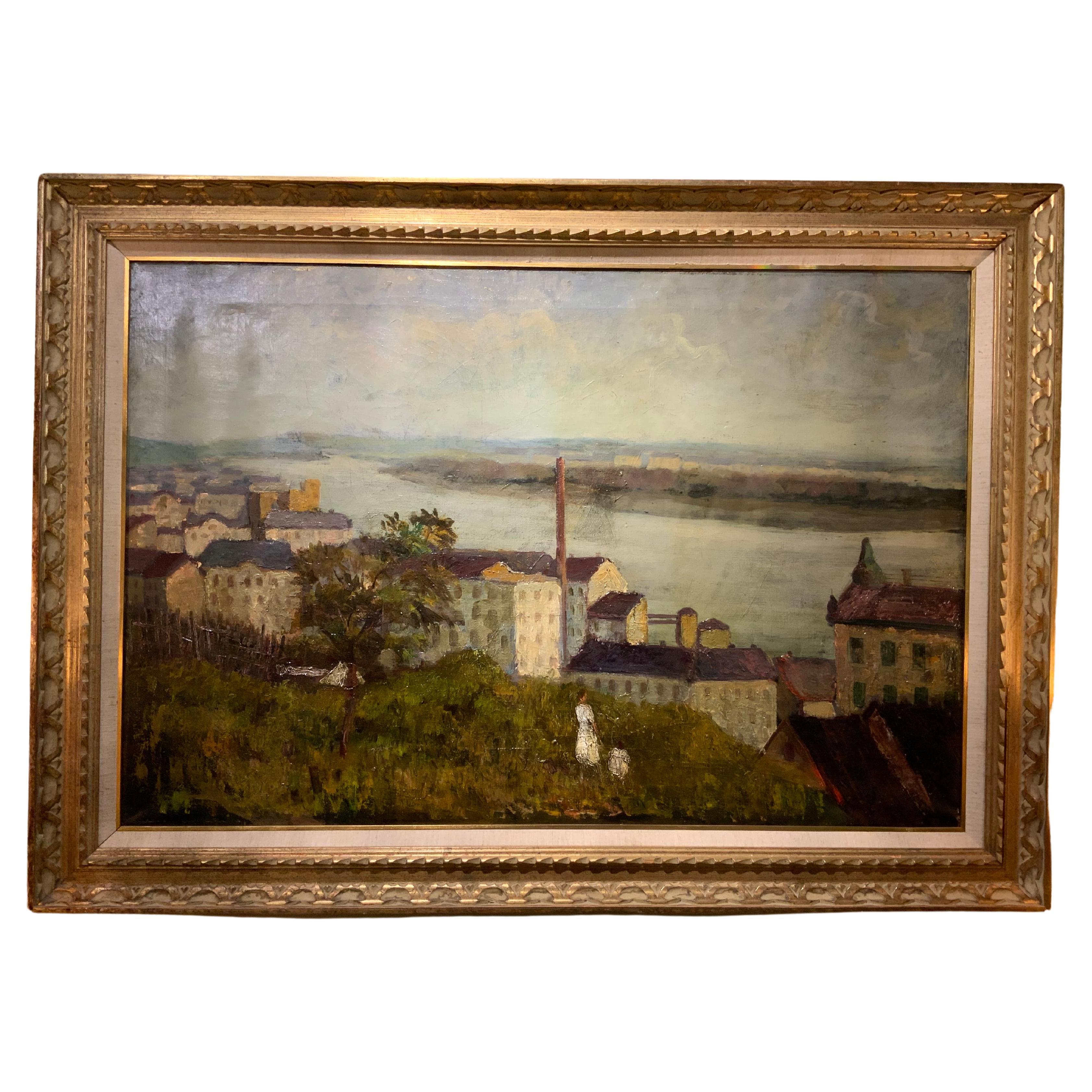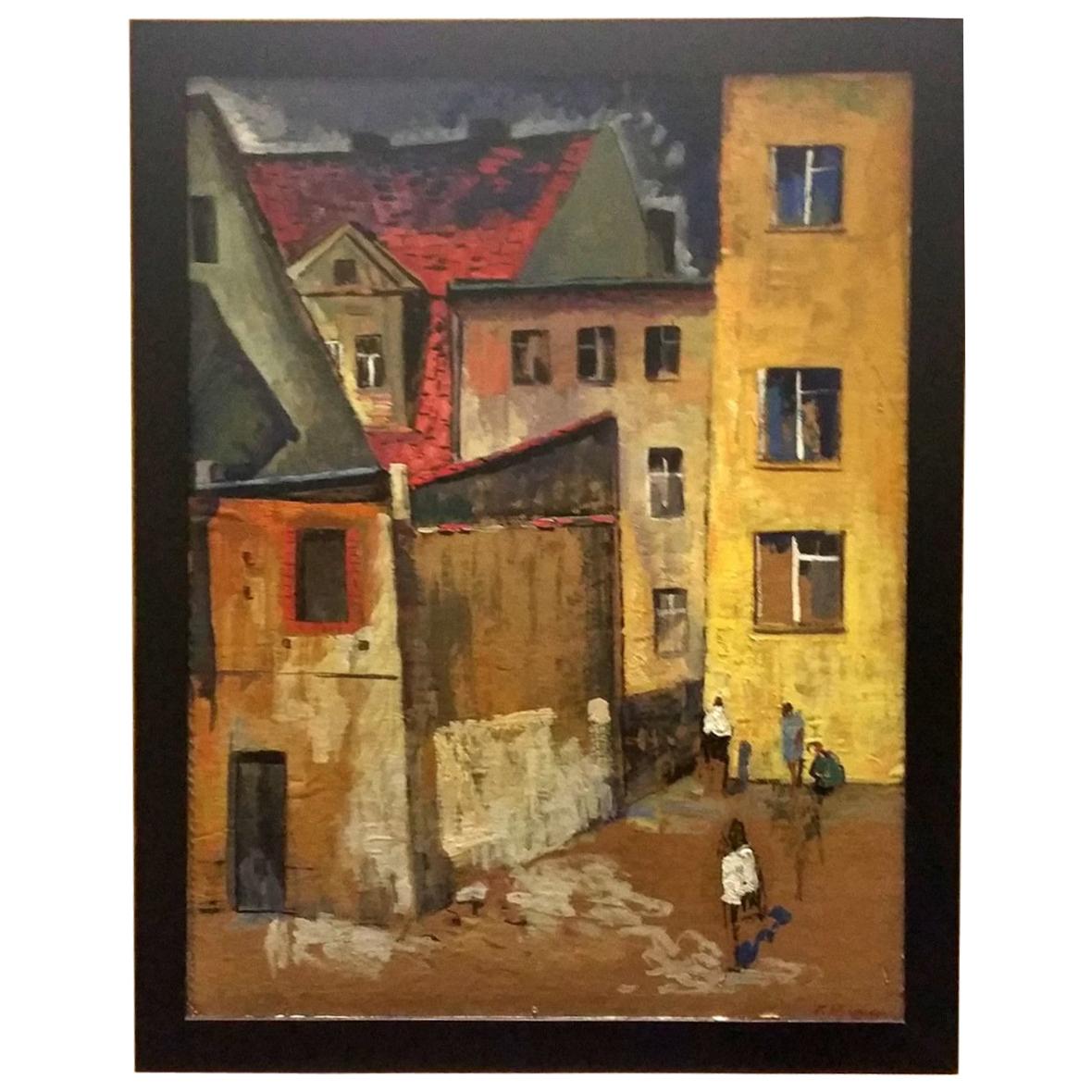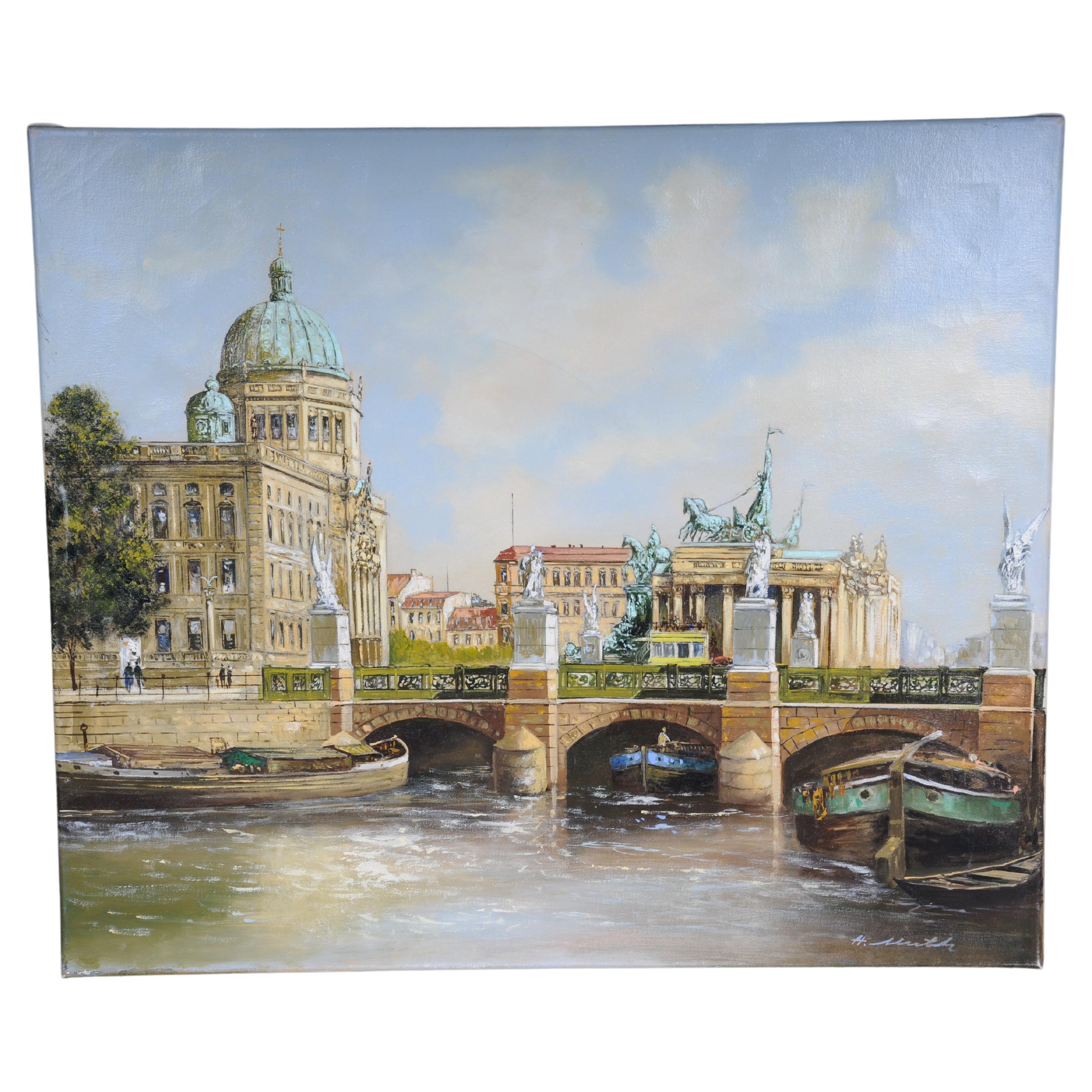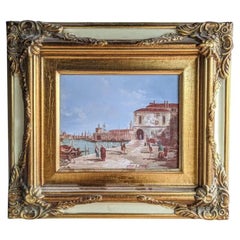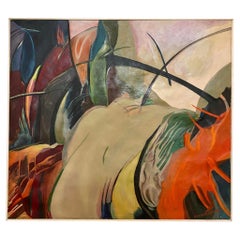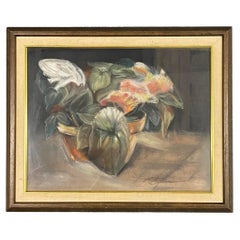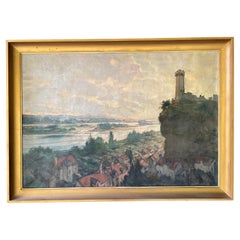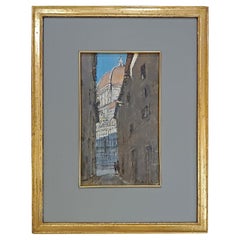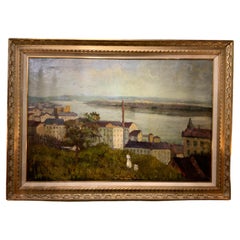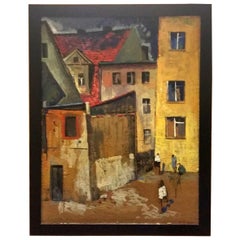Items Similar to Early 20th C. Bertha De Hellebranth Painting of Budapest Castle (Hungary)
Want more images or videos?
Request additional images or videos from the seller
1 of 21
Early 20th C. Bertha De Hellebranth Painting of Budapest Castle (Hungary)
$2,250per item
£1,708.16per item
€1,953.77per item
CA$3,143.58per item
A$3,496.34per item
CHF 1,825.68per item
MX$42,546.78per item
NOK 23,316.74per item
SEK 21,866.99per item
DKK 14,581.75per item
Quantity
Shipping
Retrieving quote...The 1stDibs Promise:
Authenticity Guarantee,
Money-Back Guarantee,
24-Hour Cancellation
About the Item
Early 20th c. Bertha De Hellebranth oil on canvas of Budapest castle. Signed lower right.
Heavy age wear to surface including craquelure and heavy edge wear. Very worn aesthetic that is only for those who appreciate an un-restored antique with deep and natural signs of distressing.
Biography by Patricia L. Fazekas Patricia L. Fazekas is a curatorial consultant and former curator of the Museum of the American Hungarian Foundation.
Bertha de Hellebranth and her sister Elena were born into a cultured upper-class family in Budapest, Bertha in 1899, Elena in 1897. Their father was a lawyer and their mother a student of Franz Liszt's last living pupil. Both sisters showed artistic potential early, beginning to paint at four or five years of age. Their parents encouraged them, and had the means to send them to the best art schools of the time. They studied at the Academy of Fine Art in Budapest, at the Académie Julian and the Académie de la Grande Chaumière in Paris, and painted portraits of European nobility. As Patricia Fazekas points out, "Growing up in a family of privilege, they seemed to have unusual access to many illustrious people." So we should not be surprised to find among their subjects members of high society, such as Count Andrássy Gyula, the Russian-born Princess Baby Galitzine, and Admiral Horthy Miklós, the Regent.
Later on, their subjects included American heiress Gladys Vanderbilt (Countess László Széchenyi), President Theodore Roosevelt's granddaughter Paulina Longworth and former President Dwight D. Eisenhower.
Often, the sisters would paint the same subject at the same time, offering the sitter a choice of portraits. Most often, the sitter wanted both renditions. While Elena concentrated on working in oil and watercolor, Bertha used gouache and oil to achieve her effects.
Elena gave lectures and workshops, was a writer and also wrote popular and ecclesiastical music, while Bertha also went in for sculpture and handicrafts.
From the mid-thirties until World War II, Bertha and Elena divided their time between their home in Budapest and a home on the ocean at Ventnor, NJ. In 1925, they showed their work at the Nemzeti Szalon in Budapest, and in 1926, they had a joint exhibition of their portraits in the US. Both exhibited their work at the Art Institute of Chicago, the Brooklyn Museum of Art, the Pennsylvania Academy of Fine Arts and most major museums and galleries in the US. Bertha also had exhibits at the Metropolitan Museum of Art. Both Bertha and Elena were Fellows of the Royal Society of Art (London), and garnered numerous prizes. Bertha was awarded First Prize by the National Academy of the American Water Color Society one year, and the Grand Prize of the Audubon Society. She was one of the founders of the now defunct World League of Hungarian Artists Abroad (Külföldi Magyar Képz?m?vészek Világszövetsége), and received a Gold Medal from the Cleveland Árpád Akadémia in 1963. (Elena also received the Akadémia's gold medal in 1965.) Their work is found in museums and galleries too numerous to mention.
The de Hellebranth sisters were devout Catholics, and this is evident in their many portraits of clerics and religious subjects. Bertha's religious sculptures include not only the Patrona Hungariae which was given to St. Emery Church by the Transylvanian Franciscans in 1957, but also several now in the Museum of the American Hungarian Foundation in New Brunswick, NJ, as for example a statue of St. Francis and another of Christ. Elena contributed several folk style panels to the Hungarian Pavilion's display at the 1939 New York World's Fair, while Bertha exhibited a couple of sculptures, one entitled "Sleeping Shepherd".
Bertha and Elena became American citizens in the 1940's, but as Elena remarked, "While we are Americans, the Hungarian blood still boils through us."
And Patricia Fazekas relates, "Following the 1956 Hungarian Revolution, the sisters organized relief efforts for Hungarians, sending much-needed shipments of clothing and food back home.” Elena settled in Atlantic City, NJ. Neither she nor Bertha married. Bertha died at age 81, in December of 1980. Elena outlived her by eight years, dying in February 1988, at age 91.
The following description is tangentially related information from a currently available auction of letters by Bertha's sister, Elena to her friend, Irene Rice Pereira:
On offer is a tremendous cache of letters, beautifully and artistically written, from and to Painter, critic, teacher, lecturer, writer, illustrator, Elena Maria de Hellebranth, who, along with her sister Bertha, gained a bit of local renown in their native Hungary, as well as in the Northeast United States, where they lived for many decades. All the letters are either from, or addressed towards, Elena’s friend and confidant, Irene Rice Pereira, a famous American abstract painter as well as a poet and philosopher. Irene Pereira has artworks displayed many museums in America, including the Whitney Museum, the Museum of Modern Art, the Smithsonian American Art Museum, the Art Institute of Chicago, and others. Elena would never achieve the level of fame and recognition as her friend Irene Pereira, or even her sister Bertha de Hillebranth. This cache of letters is a tremendously interesting exchange between two artists and friends in the 1960s. Many of the letters are not dated, but the ones that are are from 1963 to 1965. They deal with ideas about art, poetry, philosophy, God, and other topics of the humanities. Elena heaps praise onto Irene in almost all her letters to her, repeatedly calling her a genius, ending letters, “God bless you and your art,” and assuring Irene that her art and poetry will be forever be acclaimed. It seems that both Elena and Irene are very religious (or at least God-loving) women, as their letters are filled with allusions to Christianity and the divine quality of art. The cache contains a total of 18 letters, two telegrams, and one postcard. All but one of the letters is typed, and most pen marks for punctuation as well as a the letter’s signature. Only two of the letters are from Irene Rice Pereira back to Elena. One of these letters contains a postcard of an artwork by Irene. The rest of the letters, telegrams and postcard are from Elena to Irene. The letters from Irene to Elena are strongly spiritual, and also show a strong sense of paranoia. In one letter, dated March 19th, 1964, Irene writes: “I now know and I am sure of it, that it i Catholicism that is the great force of the future, possessing all the elemental, fundamental attributes of the spiritual forces for the future form of consciousness. Also it is Catholicism that heroically endeavors to save the Form of Man against that discrepancies of the finite and infinite in Greek thought. It is only Catholicism that has the theological potentiality for the mind stabilizing the spiritual forces for the infinite abundance of reality. It would give me great hope for the future if this work could find its spiritual home...My dear, dear Elena and Bertha, write me. I am very careful about my telephone because the line is tapped. This is because the tastemakers in art want to maintain the status quo; that is, they propose the styles for mass culture, and the spiritual forces in this work runs counter to their plans.” From Elena to Irene: “Dearest Irene, Always it is good to hear your voice: no matter how, but it is awe inspiring to be in touch with genius. --- This is praying that you are better. It is magnanimous of you to want to help in giving my sister Bertha the prize for her tempera and india ink study to a stained glass window. The title is “A Song was Born: The Magnificat”, and the approximate size is 22 X 25 outside. The Gospel tells us that Mary the Mother of God visited her cousin Elizabeth, when Mary expected her Child, - it may have been in the third month of her pregnancy about end of June (the Immaculate Conception occurred on the 25th of Mar...) Then, Elizabeth joyous exclamation brought forth the Virgin Mary the ecstatical: “Magnificat song, praising God!...I am most anxious to hear your verdict about her art. Bertha has a number of stained glass windows in private collections, and one at the Convent of the Visitation on City Line. All my love to you as ever, and you may call me an optimist, but I fervently believe and KNOW that your theory will come out triumphantly and that the world will acclaim you and your art, in the near future. Amen!”; “May 21st. Dear Irene, Felicitations, and congratulations to your wonderful exhibit, have heard of it from several sources, and can hardly wait to see it. I just got back from the South after an extended trip and found here your sweet note-- only too late to write you in time. Many many thanks for your thoughts and the evr so beautiful wordings. You are a poet -- too.” The items in the cache are all in good to very good condition. Some show discoloration and small tears, but there are none that are not structurally intact and easily legible and readable. As mentioned, the archive is made up of 18 letters, two telegrams, and one postcard, almost all of which are typed and signed in pen. (Background: Irene Rice Pereira (August 5, 1902 – January 11, 1971) was an American abstract artist, poet, and philosopher who played a significant role in the development of modernism in America. She is known for her work in the Geometric abstraction, Abstract expressionist, and lyrical abstraction genres and her use of the principles of the Bauhaus school. Pereira's paintings and writings were influenced significantly by the complex intellectual currents of the 20th century.
- Dimensions:Height: 37 in (93.98 cm)Width: 31 in (78.74 cm)Depth: 1 in (2.54 cm)
- Style:Art Deco (Of the Period)
- Materials and Techniques:
- Place of Origin:
- Period:
- Date of Manufacture:circa 1920s
- Condition:Wear consistent with age and use. Minor losses. Heavy age wear to surface including craquelure and heavy edge wear. Very worn aesthetic that is only for those who appreciate an un-restored antique with deep and natural signs of distressing.
- Seller Location:Round Top, TX
- Reference Number:1stDibs: LU9779243650682
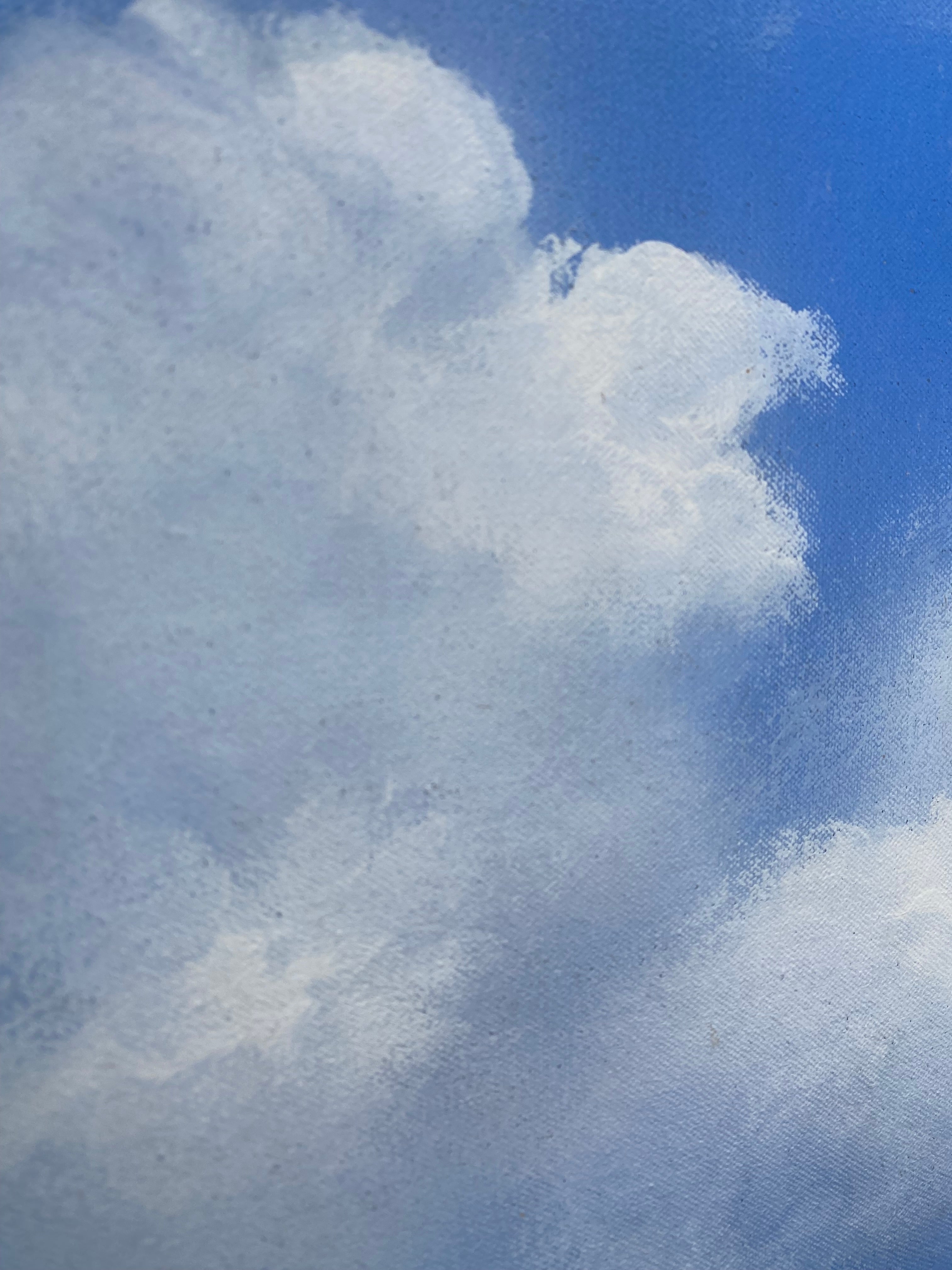
About the Seller
5.0
Platinum Seller
Premium sellers with a 4.7+ rating and 24-hour response times
Established in 2008
1stDibs seller since 2024
33 sales on 1stDibs
Typical response time: <1 hour
- ShippingRetrieving quote...Shipping from: Round Top, TX
- Return Policy
Authenticity Guarantee
In the unlikely event there’s an issue with an item’s authenticity, contact us within 1 year for a full refund. DetailsMoney-Back Guarantee
If your item is not as described, is damaged in transit, or does not arrive, contact us within 7 days for a full refund. Details24-Hour Cancellation
You have a 24-hour grace period in which to reconsider your purchase, with no questions asked.Vetted Professional Sellers
Our world-class sellers must adhere to strict standards for service and quality, maintaining the integrity of our listings.Price-Match Guarantee
If you find that a seller listed the same item for a lower price elsewhere, we’ll match it.Trusted Global Delivery
Our best-in-class carrier network provides specialized shipping options worldwide, including custom delivery.More From This Seller
View AllVenice Painting in Gilt Frame (Italy)
Located in Round Top, TX
Italian oil on canvas painting of Venice, circa late 19th c. Featuring a canal scene, full of detail in the terra cotta tile roof tops and sailboat masts. Beautifully composed and fr...
Category
Mid-20th Century Italian Mid-Century Modern Paintings
Materials
Wood, Paint
New York City Gouache Painting in Giltwood Frame
Located in Round Top, TX
Acquired from the estate of a Dallas-based illustrator, this wonderfully painted gouche on corrugated paperboard maintains the perfect balance of casualness and luxuriousness that fe...
Category
Late 20th Century American Mid-Century Modern Decorative Art
Materials
Giltwood, Paper
Bold Abstract Framed Oil Painting by Andrzej Kowalczyk (Poland)
Located in Round Top, TX
Colorful signed abstract original painting by Andrzej Kowalczyk (Poland).
Mr. Kowalczyk was born in Cracow, and became a renaissance man, as an accomplished actor, theatre director,...
Category
Late 20th Century Polish Modern Paintings
Materials
Canvas, Wood
$1,785 Sale Price
30% Off
Art Deco 1940s Floral Still Life Painting
Located in Round Top, TX
Atmospheric pastel original still life in original period frame and displayed under glass; almost 100 years old. Signed illegibly to lower right and wired for wall display.
A very p...
Category
Early 20th Century American Art Deco Paintings
Materials
Glass, Wood, Paper
Evocative 1940s Painting of Woman in Ochre Tones
Located in Round Top, TX
Worn, weathered original painting of a lovely woman with a hand to her head. Quite stunningly evocative in nature and presentation; signed lower right. Canvas wrapped around steel fr...
Category
Early 20th Century American Art Deco Paintings
Materials
Metal
Monumental XL Original Painting by Listed Artist Ronald D. Moody (Ron Moody)
Located in Round Top, TX
Ronald D. "Ron" Moody studied under noted artist, Roger Winter at Southern Methodist University (SMU), receiving his BFA in 1973.
Two years later, he received his MA from the Univer...
Category
Late 20th Century American Expressionist Contemporary Art
Materials
Canvas, Paint
$2,565 Sale Price
25% Off
You May Also Like
Vintage 1950s French Oil Painting by Henri Miloch Castle
Located in Hyattsville, MD
Oil painting by Henri Miloch, a French artist known for his depictions of Breton maritime life. Miloch was born in Trieste, Italy, in 1898, but he spent most of his life working in B...
Category
Vintage 1950s English Mid-Century Modern Paintings
Materials
Paint
EARLY 20th CENTURY PAINTING WITH FLORENTINE VIEW
Located in Firenze, FI
Beautiful oil painting on a panel, set in a gilded frame with a wooden passe-partout. The work depicts a glimpse of a street in Florence, with the dome of the Cathedral of Santa Mari...
Category
Early 20th Century Italian Paintings
Materials
Wood, Paint
Oil on canvas “riverside city” 19th century”
Located in Houston, TX
The combination of colors make this piece highly desirable
And the size is good for overmantels and sideboards.
The artist technique is especially desirable as it evokes
A beautiful...
Category
Antique Late 19th Century French Paintings
Materials
Paint
20th Century Munteanu Gheorghe Oil Painting
Located in Prato, Tuscany
We kindly suggest you read the whole description, because with it we try to give you detailed technical and historical information to guarantee the authenticity of our objects.
20th ...
Category
Late 20th Century Moldovan Modern Paintings
Materials
Wood
20th Century Oil painting by Hermann Muth, Berlin City Palace
Located in Berlin, DE
Oil painting by Hermann Muth, Berlin City Palace
Oil on canvas, view of the Berlin City Palace with the pharmacy wing. signed lower right H. Muth.
Herman...
Category
20th Century German Paintings
Materials
Canvas
$1,706 Sale Price
20% Off
Vintage Oil Painting of Paris Signed by Romanian Artist Mariana Elas Dated 1990
Located in COLMAR, FR
A bright and airy oil painting of Paris on stretched canvas made by Romanian painter Mariana Elas. The artwork is signed and dated 1990 in the lower left corner (see photo). Mariana ...
Category
1990s Romanian Modern Paintings
Materials
Canvas, Paint
More Ways To Browse
Hungarian Deco
Hungarian Art Deco
Hungarian Art Deco Furniture
Hungarian Gold
Gold Castle
Antique Clothing Museum
Baby Line
Princess Elizabeth
Irene Brown
Metal Wall Sculptures 1980s
Used Glass Display Counter
Immaculate Conception
Mary Statue
Irene Wood
Antique Furniture Brunswick
Antique Glass Display Counter
Antique Baby Grand
1940s Telephone
